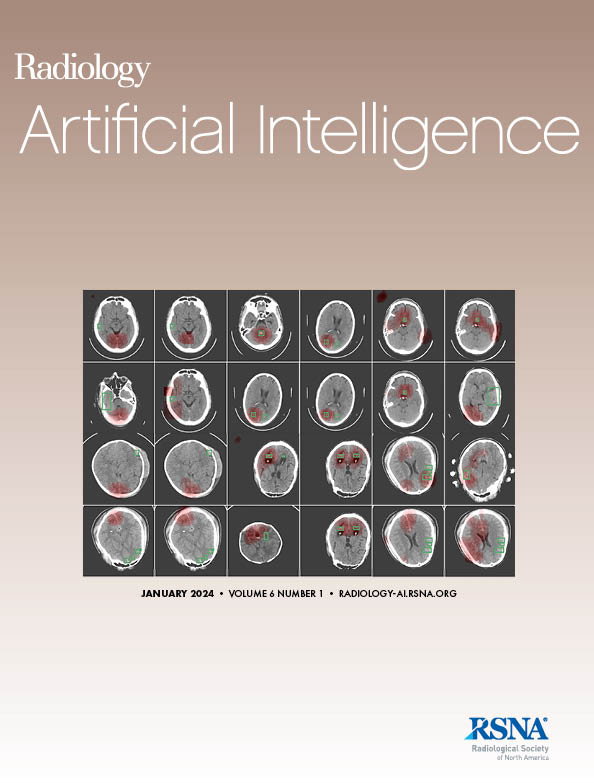Mingquan Lin, Tianhao Li, Zhaoyi Sun, Gregory Holste, Ying Ding, Fei Wang, George Shih, Yifan Peng
下载PDF
{"title":"Improving Fairness of Automated Chest Radiograph Diagnosis by Contrastive Learning.","authors":"Mingquan Lin, Tianhao Li, Zhaoyi Sun, Gregory Holste, Ying Ding, Fei Wang, George Shih, Yifan Peng","doi":"10.1148/ryai.230342","DOIUrl":null,"url":null,"abstract":"<p><p>Purpose To develop an artificial intelligence model that uses supervised contrastive learning (SCL) to minimize bias in chest radiograph diagnosis. Materials and Methods In this retrospective study, the proposed method was evaluated on two datasets: the Medical Imaging and Data Resource Center (MIDRC) dataset with 77 887 chest radiographs in 27 796 patients collected as of April 20, 2023, for COVID-19 diagnosis and the National Institutes of Health ChestX-ray14 dataset with 112 120 chest radiographs in 30 805 patients collected between 1992 and 2015. In the ChestX-ray14 dataset, thoracic abnormalities included atelectasis, cardiomegaly, effusion, infiltration, mass, nodule, pneumonia, pneumothorax, consolidation, edema, emphysema, fibrosis, pleural thickening, and hernia. The proposed method used SCL with carefully selected positive and negative samples to generate fair image embeddings, which were fine-tuned for subsequent tasks to reduce bias in chest radiograph diagnosis. The method was evaluated using the marginal area under the receiver operating characteristic curve difference (∆mAUC). Results The proposed model showed a significant decrease in bias across all subgroups compared with the baseline models, as evidenced by a paired <i>t</i> test (<i>P</i> < .001). The ∆mAUCs obtained by the proposed method were 0.01 (95% CI: 0.01, 0.01), 0.21 (95% CI: 0.21, 0.21), and 0.10 (95% CI: 0.10, 0.10) for sex, race, and age subgroups, respectively, on the MIDRC dataset and 0.01 (95% CI: 0.01, 0.01) and 0.05 (95% CI: 0.05, 0.05) for sex and age subgroups, respectively, on the ChestX-ray14 dataset. Conclusion Employing SCL can mitigate bias in chest radiograph diagnosis, addressing concerns of fairness and reliability in deep learning-based diagnostic methods. <b>Keywords:</b> Thorax, Diagnosis, Supervised Learning, Convolutional Neural Network (CNN), Computer-aided Diagnosis (CAD) <i>Supplemental material is available for this article.</i> © RSNA, 2024 See also the commentary by Johnson in this issue.</p>","PeriodicalId":29787,"journal":{"name":"Radiology-Artificial Intelligence","volume":" ","pages":"e230342"},"PeriodicalIF":13.2000,"publicationDate":"2024-09-01","publicationTypes":"Journal Article","fieldsOfStudy":null,"isOpenAccess":false,"openAccessPdf":"https://www.ncbi.nlm.nih.gov/pmc/articles/PMC11449211/pdf/","citationCount":"0","resultStr":null,"platform":"Semanticscholar","paperid":null,"PeriodicalName":"Radiology-Artificial Intelligence","FirstCategoryId":"1085","ListUrlMain":"https://doi.org/10.1148/ryai.230342","RegionNum":0,"RegionCategory":null,"ArticlePicture":[],"TitleCN":null,"AbstractTextCN":null,"PMCID":null,"EPubDate":"","PubModel":"","JCR":"Q1","JCRName":"COMPUTER SCIENCE, ARTIFICIAL INTELLIGENCE","Score":null,"Total":0}
引用次数: 0
引用
批量引用
Abstract
Purpose To develop an artificial intelligence model that uses supervised contrastive learning (SCL) to minimize bias in chest radiograph diagnosis. Materials and Methods In this retrospective study, the proposed method was evaluated on two datasets: the Medical Imaging and Data Resource Center (MIDRC) dataset with 77 887 chest radiographs in 27 796 patients collected as of April 20, 2023, for COVID-19 diagnosis and the National Institutes of Health ChestX-ray14 dataset with 112 120 chest radiographs in 30 805 patients collected between 1992 and 2015. In the ChestX-ray14 dataset, thoracic abnormalities included atelectasis, cardiomegaly, effusion, infiltration, mass, nodule, pneumonia, pneumothorax, consolidation, edema, emphysema, fibrosis, pleural thickening, and hernia. The proposed method used SCL with carefully selected positive and negative samples to generate fair image embeddings, which were fine-tuned for subsequent tasks to reduce bias in chest radiograph diagnosis. The method was evaluated using the marginal area under the receiver operating characteristic curve difference (∆mAUC). Results The proposed model showed a significant decrease in bias across all subgroups compared with the baseline models, as evidenced by a paired t test (P < .001). The ∆mAUCs obtained by the proposed method were 0.01 (95% CI: 0.01, 0.01), 0.21 (95% CI: 0.21, 0.21), and 0.10 (95% CI: 0.10, 0.10) for sex, race, and age subgroups, respectively, on the MIDRC dataset and 0.01 (95% CI: 0.01, 0.01) and 0.05 (95% CI: 0.05, 0.05) for sex and age subgroups, respectively, on the ChestX-ray14 dataset. Conclusion Employing SCL can mitigate bias in chest radiograph diagnosis, addressing concerns of fairness and reliability in deep learning-based diagnostic methods. Keywords: Thorax, Diagnosis, Supervised Learning, Convolutional Neural Network (CNN), Computer-aided Diagnosis (CAD) Supplemental material is available for this article. © RSNA, 2024 See also the commentary by Johnson in this issue.

 求助内容:
求助内容: 应助结果提醒方式:
应助结果提醒方式:


